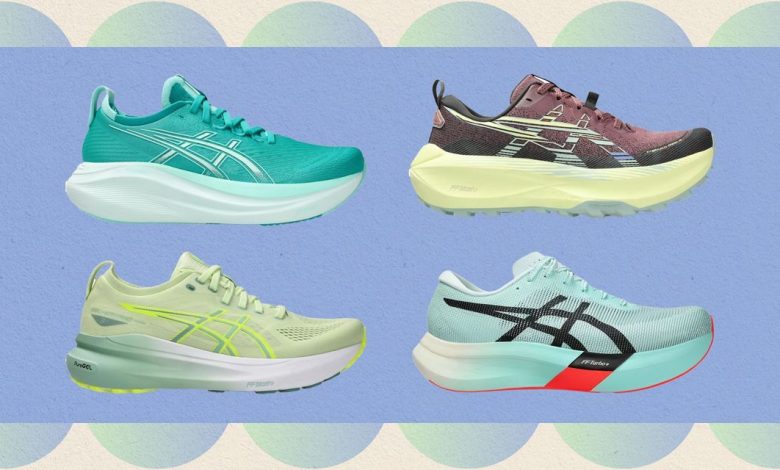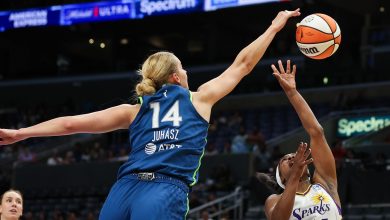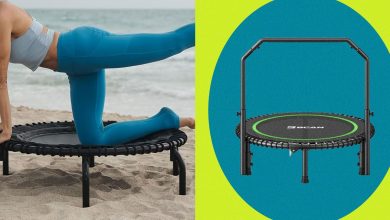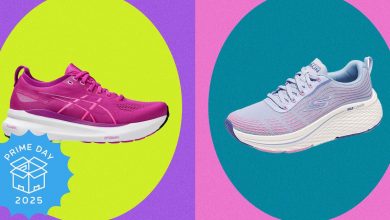Experts Agree: Your Next Running Shoes Should Be Asics

If you’re wondering where to find your next pair of sneakers, the best Asics running shoes are a worthy addition to anyone’s rotation. Long-time runners (including some SELF editors) swear by the brand’s supportive, comfy kicks—the kind you can put through the wringer, but will still feel great next time you lace them up.
“Asics are known for their reliability and durability,” Ashley Mateo, a UESCA- and RRCA-certified running coach based in Denver, tells SELF. Thanks to their sturdy construction, they offer more cushion than a lot of other shoes. It also makes them ideal for folks who like a bit more support, stability, and shock absorption when they run (whether that’s simply because they prefer the feel or because they’re injury-prone).
Not sure which pair is right for you? We spoke with experts to find the best Asics running shoes for sprints, daily runs, and more.
Our top picks
- Best Overall: Asics Novablast 5, $140
- Best for Stability: Asics Gel-Kayano 31, $165
- Best for Cushioning: Asics Gel-Nimbus 27, $160
- Best for Speed: Asics Metaspeed Sky Paris, $250
- Best for Trails: Asics Trabuco Max 4, $160
- Best for Long Distances: Asics Superblast 2, $200
- Best for Mid-Distances: Asics Glideride Max, $170
- Best for Flat Feet: Asics GT-2000 13, $140
These kicks run circles around the competition.
Best Overall: Novablast 5
If you’re looking for a shoe that will give you major versatility and the most bang for your buck, the Asics Novablast road shoe does it all. “It provides enough bounce for running fast, and it’s light enough not to weigh you down, but it also has ample cushion to support you for longer distances. You can wear it for easy runs, hard workouts, and everything in between,” Laura Norris, CPT, RRCA-certified run coach, tells SELF.
Mateo also praises the Novablast, noting that one of its previous versions performed great as her daily trainer: “It’s a super reliable shoe I can count on for easy jogs, uptempo workouts, and even long runs.” While it’s not designed for speed, its high stack of responsive foam makes it capable of picking up the pace, she says. It’s also a great option for half-marathon and marathon runners who don’t want (or need) a more expensive, carbon-plated shoe.
Sizes: US 5 to 12 | Widths: Medium and wide | Weight: 7.90 ounces | Heel-to-toe drop: 8 millimeters
Best for Stability: Gel-Kayano 31
The Asics Gel-Kayano provides stability without altering your footstrike (the part of your foot that hits the ground first as you run), says Norris. “The [level of] support is ideal for runners who may overpronate—when your ankles roll in as you land—or who have low arches, but don’t want a traditional stability shoe that impacts their gait too much,” she explains.
The midsole is made with lightweight foam, which keeps this shoe from dragging you down. A previous version of the Gel-Kayano even took home a SELF Sneaker Award, thanks to its not-too-little, not-too-much approach to stride correction and support.
Sizes: US 5 to 13 | Widths: Narrow, medium, and wide | Weight: 9.30 ounces | Heel-to-toe drop: 10 millimeters
Best for Cushioning: Gel-Nimbus 27
The Asics Gel-Nimbus offers a cloudlike ride, with a high stack height (there’s over 42 millimeters of material between your heel and the ground) and a sleek silhouette. “It’s so plush and cushy, your foot just feels like it’s being hugged through every part of the gait cycle,” says Mateo.
All that padding makes it a great option if you deal with heel pain related to plantar fasciitis. Carla Gamez, DPM, a podiatrist at Illinois Bone & Joint Institute (IBJI), previously recommended the Gel-Nimbus to SELF, noting that its cushy, shock-absorbing design should help relieve some pressure on your heels.
Best for Speed: Metaspeed Sky Paris
Need a new race day shoe or sneaks for tough sprint workouts? Check out the Sneaker Award–winning Metaspeed Sky Paris, an impressively lightweight shoe that our tester described as “super bouncy and fast.”
“They feel light, comfortable, and definitely like they’re powering me forward—like an extension of my foot, but one that makes me springier and speedier,” they said. That feeling of propulsion comes from the shoe’s carbon plate, while the springiness our tester noted is due to the updated, energetic foam in the midsole. “They were equally fun on the pavement and on the track,” they added.
Sizes: US 5 to 14.5 | Widths: Medium | Weight: 6.50 ounces | Heel-to-toe drop: 5 millimeters
Best for Trail Running: Trabuco Max 4
If you’re looking to run long and go off-road, the Trabuco Max 4 is a great option. Its wide platform is padded with foam to keep you comfortable and absorb the impact from your steps, while its rocker sole helps you maintain momentum. The rubber outsole also has aggressive lugs that grip the ground when navigating tricky terrain.
Just keep in mind that the Gel-Trabuco 12 isn’t waterproof. If that’s a trail running shoe must-have for you, consider Asics’s Gel-Sonoma 8 GTX, which uses a Gore-Tex membrane to seal out rain and snow.
Sizes: US 5 to 12 | Widths: Medium | Weight: 9.45 ounces | Heel-to-toe drop: 5 millimeters
Best for Long Distance: Superblast 2
If the Novablast and Metaspeed had a baby, you’d get the Superblast. “The midsole combines a big hunk of lightweight and responsive foam, and the bottom layer has a soft, bouncy foam,” Mateo says. The sole might look thick and unwieldy, but she says its layered design keeps you grounded: “There’s no wobbling—that bottom layer of foam helps stabilize the top.”
The Superblast doesn’t have a carbon plate. But in Mateo’s experience with previous versions of the shoe, the glue that holds the two foams together adds rigidity without feeling too stiff. “You’re not going to get quite the same pop of a plated shoe on tired legs, but this multitasker can handle long, easy runs as well as it can handle race day,” she says.
Sizes: US 5 to 14.5 | Widths: Medium | Weight: 8.80 ounces | Heel-to-toe drop: 8 millimeters
Best for Mid-Distance: Glideride Max
The Glideride is a solid choice for half-marathon enthusiasts. It combines energy return with cushioning to help you run fast and far—exactly what you need during a 13.1-mile race.
The curved rocker bottom allows you to push off smoothly with each stride, and the midsole provides a springy rebound without weighing the shoe down a ton. The pros approve too: “This shoe makes easy runs and recovery runs feel light and smooth, even if your legs are tired. It can also work for longer runs, since it has ample cushioning,” says Norris.
Sizes: US 5 to 12 | Widths: Medium and wide | Weight: 9 ounces | Heel-to-toe drop: 6 millimeters
Best for Flat Feet: GT-2000 13
It can be hard to find a shoe that supports your arches without feeling heavy, but the GT-2000 13 toes that line nicely. It uses Asics’s 3D Guidance System technology to prevent your feet and ankles from rolling inward, but still bends and flexes with your foot when you’re on the move.
An earlier iteration of the Asics GT-2000 won a Sneaker Award back in 2021. “This shoe feels completely natural,” our tester wrote then, adding that its comfy padding didn’t interfere with their natural stride. “I felt like I both had contact with the road, but also adequate protection from it.”
Sizes: US 5 to 13 | Widths: Narrow, medium, and wide | Weight: 8.30 ounces | Heel-to-toe drop: 8 millimeters
What should you look for in Asics running shoes?
“The right running shoe is the one that you never think about when you’re actually running,” Mateo says. First and foremost, that means finding shoes that fit well. For a comfortable, pain-free ride, your running shoes should actually be bigger than your regular kicks, Alicia Canzanese, DPM, ATC, a board-certified podiatrist, athletic trainer, and former collegiate track athlete, previously told SELF. You want to be able to move your toes, so a thumbnail’s length of extra space at the front of the shoe is ideal.
There should be no rubbing or pressure around the laces or tongue; and the back of your heel should be secure, so it doesn’t slip around. Make sure your arch is supported too—it should feel cradled, not like it’s collapsing or forced upwards.
If you’re looking to run longer distances or you’re concerned about shock absorption, thick cushioning might be a priority. But if you’re reaching for speed goals, a thinner, more responsive midsole (a.k.a. one that feels springy) might be important. A lightweight shoe can help you conserve some energy, while heavier padding can keep your feet pain-free over long miles and rocky terrain.
A shoe with a height difference between its forefoot and heel (known as the shoe’s “drop”) may feel more comfortable for runners with calf or Achilles tendon issues, but could aggravate hip and knee problems. Think about what most of your runs will look like and what you prefer in other sneakers. Do you usually wear flatter, more minimalist shoes, or something ultra-cushy?
If you’re looking for specialized sneaks, like a long-distance or race shoe, you might feel better and run faster in one with more performance-driven technology (like a carbon plate or a super-high stack height), says Mateo. Just keep in mind that they’ll probably be more expensive than your average sneaker. Otherwise, you don’t need to buy the priciest sneaks for the best experience.
Related:
- Podiatrists Love Hokas—Here Are the Best Pairs for Every Activity
- The Best Brooks Running Shoes for You, According to Podiatrists
- The Best Nikes for Every Type of Runner
Get more of SELF’s great product recommendations delivered right to your inbox (for free!).



